When thinking of arthritis, most people think of the back, the fingers and even the knees, failing to realize that even larger joints, such as the hips, can suffer from this degenerative disease. Arthritis refers to an inflammation of a joint that leads to pain and difficult movements. Hip arthritis is usually caused by osteoarthritis that causes joint wear and tear from excessive movement.
The hip joint is used constantly from the beginning of one’s life for walking, running, climbing and nearly all other leg movements. Over time, the protective cartilage in the ball-and-socket joint of the hip wears away, exposing the bones. This change can lead to numerous signs of arthritis around the hip joint that become progressively worse as the disease progresses.
Early Signs of Hip Arthritis
Initially, mild arthritis in hip joints causes minor signs and symptoms that can be easy to ignore or to chalk up to another problem. Individuals may notice the following issues.
- Mild pain in the hip
- Mild radiating pain in the lower back, groin or thighs especially with walking
- Difficulty spreading the legs
- Popping noises when spreading the legs
- Pain that is worse in the morning
- Increased pain with inactivity

Signs of Advanced Hip Arthritis
Of course, the symptoms for arthritis in the hip change and increase as the disease progresses. Even with treatment, this degenerative disease continues to worsen in the following ways.
- Increased pain even without weight-bearing activities
- Decreased flexibility and mobility in the area
- Limping or difficulty walking
- Difficulty getting up and down from chairs
- Hip swelling

Getting a Hip Arthritis Diagnosis
Doctors rely a great deal on a patient’s description of symptoms for making a diagnosis of hip arthritis. Many of the symptoms are difficult to see but can be acutely felt by the patient. However, doctors will also spend time during an initial consultation to discuss the patient’s past medical and surgical history as well as his or her family history of arthritis and other musculoskeletal disorders. In addition, a doctor will complete a physical examination, which could include range of motion tests and gait tests, while recommending Xrays and blood tests to check for other possible disorders.

Hip arthritis is not instantly terrible but instead develops over several months to years. It is important to catch signs and symptoms early to seek early interventions that can help individuals age gracefully without excessive pain.
